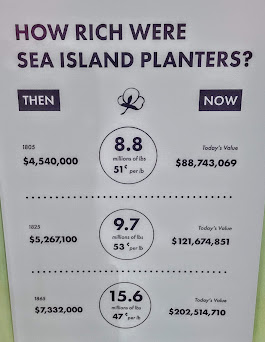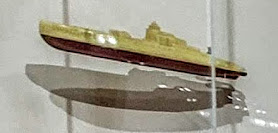Carol and I are learning a lot more about history that occurred in the South. A short drive from MCRD Parris Island is a small town called Beaufort, with a lot of history to invite visitors to see.
Like most small towns, they have small streets that were not designed for large vehicles, thank the Lord there were public parking lots. Our first stop was across the street to see a church and monument.
Here is the Tabernacle Baptist Church. It became a black members church after the white members of the church evacuated due to federal occupation in 1861. This church was also believed to have been a stopping point for a raid into the South, which reportedly brought back nearly 800 slaves. One of Beaufort's prominent black gentlemen is buried next to the church. The gentleman that is buried here on church grounds is none other than Robert Smalls. You are probably asking yourself... why is he soimportant. Let's take a good amount of time and talk about Robert Smalls. (The photo is courtesy of Florida PBS.)He was born in Beaufort as a slave in 1839, behind his owners (McKee family) city house. His mother worked in the city house, but grew up working in the fields. Robert was treated different from the other slave children, its assumed that he may have been a child from one of the McKees, or their plantation manager. Because he was being favored, his mother wanted him to see the horrors slaves dealt with everyday, so she arranged for him to work in the fields one day, and he watched slaves at the "whipping post."
The lesson made the impression Lydia was hoping for, only it made it too well... he frequently found himself in the Beaufort jail. His mom's love drove her to ask the McKees to rent him out to people in Charleston. He worked several jobs in the city, but his best educational experiences came from the waterfront. Robert became one of the most knowledgeable persons regarding Charleston harbor.
Because of his knowledge of the harbor, Robert earned his job on the ship Planter. While working on the Planter he met his wife to be. The two received permission from their owners to marry, and move into an apartment together; they had two children. Knowing that there was no guarantee they would stay together, he asked his wife's owner if he could buy his family, her owner agreed... for $800.00. Robert only had $100.00, and wondered how long it would take to earn the other $700.00. This is the point where a seed is planted, creating a memorable time in history.
Robert Smalls and the captain of the Planter could have been considered brothers, if it wasn't for the fact that the captain was white. Robert knew that his and his families freedom could only come from the sea, so he told his wife to be ready when the opportunity arose. From here we will read the event according to Navy records.
The opportunity came the night of 12 May 1862. Once the boat's officers went ashore, he confided his plan to his fellow slaves, because the plan was an extreme risk, some of the slaves didn't participate.
At 0200 (2:00am) 13 May, Robert dawned the captain's straw hat and ordered the skeleton crew to "put up" the boilers, and hoist the Confederate colors, and ease from the dock. They steamed past General Ripley's headquarters, and paused at the West Atlantic Wharf to pick up his family and other men, women and children.
At 0325 the Planter accelerates. Robert pilots the boat, blowing the boat's whistle when they passed Confederate forts Johnson and Sumter at 0415 coolly, as if General Ripley was onboard. Robert Small was so smooth... his movements emulated those of the actually captain of the boat. According to the Confederate Aide-de-Campe, the boat was the "guard boat", and allowed to pass without interruption.
Once they neared the Union blockade, Smalls ordered the Palmetto and Rebel flags be lowered, and a white bed sheet be raised. Unfortunately they were almost fired upon, but in the nick of time someone noticed the white sheet, and the boat was not fired upon. Robert Smalls turned the Planter over to the Union.
Because Smalls was not able to purchase his family, and his bravery, Congress in 1862, passed a private bill authorizing the Navy to appraise the Planter, and award Smalls and his crew proceeds for "rescuing her from the enemies of the government." Smalls received $1,500.00 as his share.
In the North Robert Smalls became a hero. He personally lobbied the Secretary of War to enlist black soldiers. In October 1862 Smalls returned to the Planter as the pilot, and part of Admiral DuPont's South Atlantic Blockade Squadron.
According to the 1883 Naval Affairs Committee report, Smalls was engaged in 17 military actions, which included the assault on Fort Sumter in April 1863. Two months later he assumed command of the Planter when it was under attack with "very hot fire" from the enemy. The reason he took command was because the white captain of the boat hid in the "coal bunker", demoralized. Because of his actions, Smalls was promoted to Captain, making him the highest paid black soldier in the war.
After the war Robert did not fall back on his laurels. Do you remember that $1,500.00 award he received for turning over the Planter, well, part of that money went to buying the manor he was born at. He pushed the boundaries of freedom, serving in the South Carolina state assembly and senate, and five non-consecutives terms in the U.S. House of Representatives (1874-1886). Unfortunately all his efforts went down the tubes in South Carolina, because in 1895 the state rolled backed back reconstruction efforts, stripping all blacks of their political rights. With the rise of "Jim Crow" laws, Smalls was a unyielding advocate for African-American political rights, stating "My race needs no special defense for the past history of them in this country. It proves them to be equal of any people anywhere. All they need is an equal chance in the battle of life."
Mr. Robert Smalls died in 1915 in the house he was born in, behind the manor.
That manor he bought, cost him $700.00 after the Civil War. He was able to buy the home when it went up for auction due to unpaid taxes. Today it is estimated to be worth $1.2 Million.
So let's talk a little about Beaufort itself. During the war most whites moved away from Beaufort, and eventually lost their homes and plantations due non-payment of taxes. Many of these properties were bought by freedmen, who continued to farm the land, no longer with slave labor.
Cotton was still king in the south, just less profitable. Antebellum cotton was ginned in different locations than it was grown, and in the Reconstruction Era, cotton was ginned locally. The area supported other agricultural crops as well.
Phosphate mining became a big deal when it was discovered that the Coosaw River, running through Beaufort county, had an abundance of phosphate... and a boom began. It was first mined by freedmen diving down to the river's bottom, with a metal basket, mining as long as their breathe held out. Eventually machines took over, able to mine tons of rocks at a time, vice baskets at a time. For 20 years the Beaufort area was the leading producer of phosphate.
Another spot of industry that helped the area was the railroad. The Port Royal Railroad opened for business in 1873, and linking the Sea Islands to the mainland with an immediate impact. Local products, like timber and cotton could now be exported north, west, east, and to Europe. Imports like coal, and guano (fertilizer made from bird droppings) could now be carried across the United States and territories. Even during economics troubles the railroad carried passengers between Port Royal, South Carolina, and Augusta, Georgia for 50 years.
Remember that teaching a slave to read was illegal before the Civil War. Education was to change in this area as well, and the freedmen were eager to learn. Port Royal was about to become an experiment in education. In 1862, Missionaries were sent to teach, but before they could, they needed a school... that would have been the Penn School, which was one of the first schools for freemen... which we will visit later. The schools in the area flourished only because there were Union military near to protect them, and this protection was provided after the war as well.
Politics was another change in South Carolina, whether it wanted it or not. Robert Smalls was a big reason where the education system changed in South Carolina, and he could rightfully be called the "father of public education" in South Carolina. In the Constitutional Convention of 1868, in Charleston, he insisted that South Carolina educate its youth at public expense. Because he championed for public education, Beaufort led South Carolina in public education. It has been said that: "had the rest of South Carolina been as foresighted as Beaufort in offering education opportunities for all its citizens, it is likely the destitution which afflicted so much of the state would have been greatly reduced."
Across the street from the National Parks Visitor Center, is the Beaufort Arsenal. The original arsenal was erected in 1798. In 1802 the Beaufort Volunteer Artillery (B.V.A.) was commissioned; their roots stemmed back to the Revolutionary War.
The original arsenal was a single story facility made from brick and tabby material. The building in the photo is the 1862 reconstruction of the arsenal. During the Civil War, the B.V.A. was stationed in Fort Beauregard, at Bay Point. After the Union attacked and captured Port Royal Sound, they took control of all the contents, using them for the U.S. Army, Department of the South. The Union used the Arsenal to store quartermaster and ordnance supplies until the end of the war.The first floor of the Arsenal accessible to visitors, is a gift shop. Part of the second floor is a museum exhibiting life on the Sea Islands. The Beaufort District survived Indian attacks, gradually business and infrastructure grew, and out sprang the King's Highway, running from Boston to Savannah. From the 1740s to the Revolutionary War, the plantation owners made their fortunes from rice and indigo... off the backs of their African slaves, as seen below. In 1700 Carolina exported 12,000 pounds of rice, without slaves. Between 1706 to 1723, they imported 4,504 slaves, and their cotton increased to 18,000,000 pounds of rice. With the slave they continued to import up to 1769, the plantations were able to export 83,000,000 pounds of rice. Looking at the chart you can see that the cotton farmers weren't exactly hurting for funds either. By 1865, they exported 15.6M pounds of cotton, raking in over $7.3M, on other people's backs.
The Beaufort District survived Indian attacks, gradually business and infrastructure grew, and out sprang the King's Highway, running from Boston to Savannah. From the 1740s to the Revolutionary War, the plantation owners made their fortunes from rice and indigo... off the backs of their African slaves, as seen below. In 1700 Carolina exported 12,000 pounds of rice, without slaves. Between 1706 to 1723, they imported 4,504 slaves, and their cotton increased to 18,000,000 pounds of rice. With the slave they continued to import up to 1769, the plantations were able to export 83,000,000 pounds of rice. Looking at the chart you can see that the cotton farmers weren't exactly hurting for funds either. By 1865, they exported 15.6M pounds of cotton, raking in over $7.3M, on other people's backs. 
These two photos are a look at the mold used to produce kazoos. After the video presentation one of the guides spoke about the different types of kazoos and accessories. After this part of the tour, we went to the back assembly area; production remains at their plant in Florida.
This is their assembly area, consisting of four stations. The first station selects the kazoo body and top colors chosen by the customer. The second station inserts a membrane in the body of the instrument, sealing it in with the cover piece. After the kazoo is assembled itwill move to one of two stations before boxing. If the kazoos do not require wording, it goes to one of the packaging machines. One machine packages them individually, the other in bulk packaging. The last station is a machine that labels the kazoo with the requested wording before it goes to packaging. One stationnot mentioned was a station making the membranes in bulk production. Once the kazoos are finished, the order is boxed for shipment.After the tour in the assembly area, visitors return to the museum for their opportunity to make their own kazoo. The purple and green kazoos are ones Carol and I made. Having made our kazoos, we moved to the museum.
The kazoo got its start in the 1880s, and looked more like a duck call.At one point the kazoo was so popular, 10,000 were sold in one week in Rochester, New York. Over the years many styles of kazoos were manufactured. Are you ready to see a couple?
Popeye Pipe, Northwestern Products, circa 1934.Submarine Kazoo, circa early 1900s.
Dagwood Sandwich Kazoo, made by Midwest Corporation, circa 1947.
Saxophone Kazoo, circa 1950s.
Theory #1: Alabama Vest, and African-American, invented the kazoo, and built it with the help of German clockmaker, Thaddeus Von Clegg. They showed their instrument at the Georgia State Fair in 1852.
Lucy made and played her instruments, as well as renting them out to other groups around the country. The Susie's Kitchen Kabinet Band performed across America from the 1920s to the late 1950s.
I promised you more on the Penn School, the first formal school in the South for freed slave students. But first we need to drive to St. Helena Island, South Carolina, a few miles from Beaufort. I highly encourage you to visit their website: https://www.penncenter.com because I will only be showing a portion of their history.
This house is the Pine Grove Cottage, built in 1921 by school students under the direction of the Carpentry Instructor, Mr. Benjamin Boyd; Mr. Boyd was the instructor at Penn from 1919 to 1948. It was originally the home for the school superintendent, today it is the guest house for visitors to Penn School.
The Arnett House was built in 1937 by the islanders and students. It was named in honor of Dr. Trevor Arnett, who was one-time President of the General Education Board of Penn School. At one time it housed student teachers from South Carolina State University, who worked in the county schools.
This building, built in 1905 was named after a Frenchman, Anthony Benezet, who stood for freedom in the mid-and late 1870s. This was home for female students and teacher, and the focal point of the home economics classes for female students; it was required that female students live in Benezet before they could graduate. Males were only allowed in the building when chapel services were held in the ground floor lobby.
death, he was never able to hold meetings here. This house is a replacement for the Palmetto Cottage that was in 1920, and burnt down in the 1950s. This house and dock were completed in 1968. When we visited the house, the tide was low, and oyster shells could been seen everywhere.
This experience was fun and educating. It was our last stop in South Carolina... this trip.












.jpg)



































